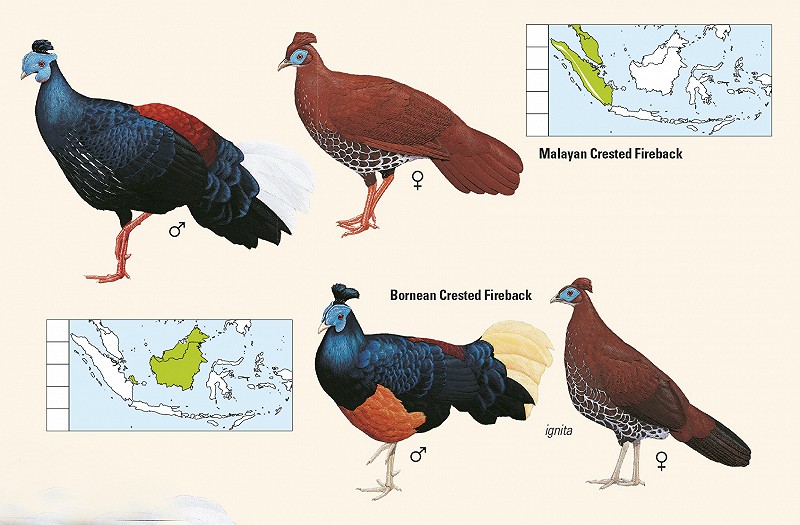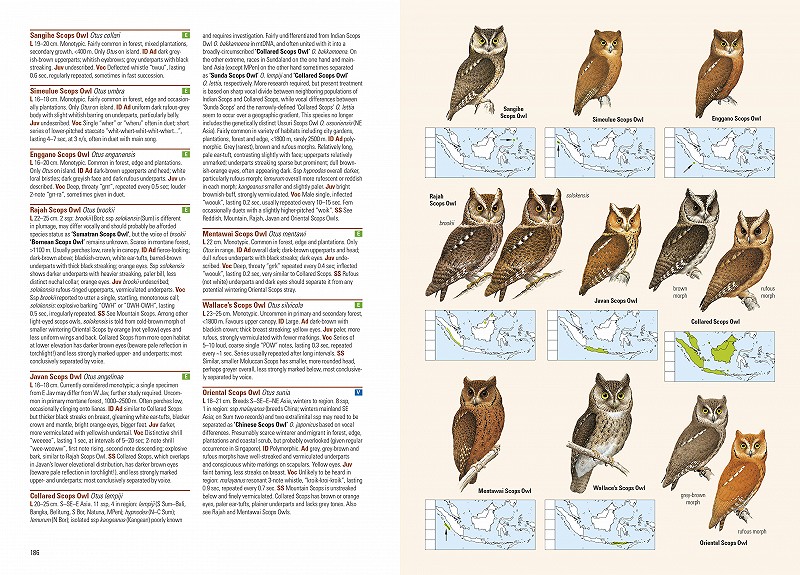Birds of the Indonesian Archipelago. Greater Sundas and Wallacea
18 November 2016 · Vincent van der Spek · 8609 × bekeken

Eaton, J. A, B van Balen, N. W. Brickle & F. E. Rheindt. Lynx Edicions. Barcelona. 496 pp, more than 2,500 illustrations. Hardcover. Price: € 65
Long over due, but finally a fact: this long awaited book is good. It's a major leap forward compared to current guides, but it does have some limitations.
The Indonesian archipelago has long been an odd case in modern ornithology. With well over 1400 species, the archipelago is the most species rich region in Asia. With so many islands, divided over several biogeographical regions (the famous Wallace's Line!), endemism is extremely high: over 600 (!) species are unique to the region. No wonder it's one of the world's major birding destinations. Yet, there was no single volume field guide. This new guide finally fills that gap.
The need for a guide
The guide covers the entire Indonesian territory except West Papua, but does include Brunei and the Malaysian regions of Sabah and Sarawak on Borneo, as well as East Timor. More about that choice later.
Borneo has been covered in several good, recent field guides. But all other regions were in desperate need of a new guide. Sure enough, Sumatra, Java and Bali were covered by Mackinnon & Phillipps (1991), but while this was a decent guide at the time, it is now seriously outdated. The only guide for Sulawesi, the Moluccas and Lesser Sundas was The Birds of Wallacea (Coates & Bishop 1997). A good guide (though confusing at times!), but it has been out of print for ages. Since Sulawesi and Halmahera have become such popular destinations, second hand copies are sold for 100s of Euros in the internet. Well, that (mal)practice will be something of the past soon.
Seasoned birders
Lynx recognised the gap and four leading ornithologists of the region - including Dutchman Bas van Balen as the second author - took up the task to fill it. What makes this team of authors special is that they are both academic (with a long list of publications) and practical in their approach: they are also seasoned birders that have travelled to the remotest corners of the archipelago, acquiring a deep knowledge of the birds and their identification, behaviour and ecology.
HBW
On recent trips to the area friends and I created our own field guide: a pocket sized hardcover with a selfmade layout (it actually looked good!), mainly based on HBW Alive. Since the artwork of this new field guide is largely based on HBW, I already worked with a selection of the plates of this new book in the field, which really helps writing this review.
Elegant taxonomical solution
With Frank Rheindt the team has a true taxonomical expert: this professor in phylogenetics and advisor to the IOC is the author of many articles on the subject. While they chose not to follow a specific taxonomical list (there's no regional committee anyway), they explain they were not too tempted to do some good old 'field guide splitting' either. Hence, new splits that have not been formally described have not been included. But they also realise that with the ever expanding knowledge of bio-acoustics and phylogenetics, taxonomical changes are so common that they are hard to keep up with.
They found an elegant solution to combine the best of both worlds: the so-called ‘limbo split’. Taxa that likely represent full species, but for which a decent publication is still lacking, or existing splits for which the current evidence is considered too weak, are treated separately, but without being presented as "definite" splits. Having said that, this book is progressive: it includes splits that are (currently) not recognized by any of the world lists, not even by Rheindt's "own" IOC. For example the well-known races of Malayan and Bornean Crested Fireback are treated as full species here. Yet undescribed species are also added, like the parrotfinch on West Timor discovered by first author James Eaton a few years ago. Salient detail: many splits, for instance Western and Eastern Superb Fruit-dove or Checker-throated and Javan Woodpecker, are treated as limbo splits by the fathers (the authors) of this book, whereas the mother (HBW) treats them as full species. On the other hand, there are also splits in this book that are not (yet?) incorporated in HBW Alive: there's e.g. a whole new set of cuckoo-doves (also split by the IOC). Both popular and scientific bird names sometimes also differ from those in HWB Alive (though alternative names are given in the species accounts, which I always find valuable). It's good to see that Lynx allowed the authors to make decisions that are not always on par with Lynx's most successful product (HBW).  Example page: Firebacks
Example page: Firebacks
The plates, species accounts and maps
It's commonly acknowledged that most of the work in HBW is (very) good, though the earlier volumes perhaps have weaker plates than the later ones. The latter is for instance noticeable in the seabirds, which is further emphasized by the dark print of my book: some dark seabirds like Flesh-footed Shearwater look nearly green! Some of the work of my favourite artists like Brian Small and Jan Wilczur is included. In this guide new plates were added and, as mentioned in the acknowledgements,"numerous" plates were adjusted, though nowhere it becomes clear how big the overlap/difference with HBW actually is. I mainly noticed differences in the splits, with again the cuckoo-doves as an example.
Species accounts are on the opposite page of the plates, a lay out that I prefer in field guides. It's easy to work your way through the guide, though the taxonomical order is - again - different from other books from the Oriental region (for which Rheindt nearly apologizes). Maps are right next to the plates. With so many species to cover, it's no wonder that the species accounts are often short and the plates are sometimes small. Like in HBW many species only have one or two plates. For most species this works fine (as said I already worked with HBW plates in Indonesia): they are either (fairly) unique and easy to recognise, or very similar species can easily be ruled out based on geography alone (most owls and bush warblers for instance). I noticed several updates in the maps, and that surely helps. However, for some groups the combination of a small species account and a small and single plate works less well - my only true comment on this book. To me the swiftlets are the most obvious example. The plates of these very similar birds are not the best that HBW has to offer, most species have only plate, and for some species only the upperparts are shown, whereas in others only the underparts are depicted. Another example are the always difficult sparrowhawks: only adults (often males) are depicted in flight. Also, illustrations do not always seem to be to scale. I am however impressed by how much relevant information is presented in the short species accounts. And some of the more difficult or variable species do have longer accounts. I realise that's it's an incredibly difficult task to treat so many species in a single volume bird book and that therefore choices have to be made.
This leads to a question. Since Borneo is well-covered in other guides (though admittedly many of the plates in this book are better), wouldn't it have been a great idea to leave the island out all together - like West Papua was also left out? Of course this would mean that not the entire Indonesian part of the Greater Sundas would be covered, but it could have saved valuable space for longer species accounts and larger and perhaps even more plates, especially for the difficult species groups.  Example page: Scops Owls
Example page: Scops Owls
Example page: Laughingthrushes
However, just buy it...
With the overall high quality of the plates, the spot on and relevant species accounts and the clear maps the vast majority of the birds can be identified without difficulty, which is a major achievement for a region with so many species. Just try and find some extra sources for the most difficult birds. For Sumatra, Java, Bali and Wallacea this guide surely is the guide for all trips to the area and I can only wholeheartedly congratulate and thank the authors for their achievement. If you're interested in the Indonesian archipelago, or in the Oriental region as a whole: just buy this book. The only reason I've not thrown my illegally home made HBW book in the dustbin, is for sentimental reasons.
Vincent van der Spek
References
Coates, B & D Bishop. A guide to the birds of Wallacea: Sulawesi, the Moluccas and Lesser Sundas: Indonesia. Dove Publications, Australia.
Mackinnon, J & K Phillipps, 1991. A field guide to the birds of Borneo, Sumatra, Java and Bali. Oxford.
Discussie
Jan Hein van Steenis
·
22 November 2016 15:33
Dit is natuurlijk een must-buy...
Borneo weglaten had ik merkwaardig gevonden, gezien de grote overlap met Sumatra en Java (Welke gidsen zou je voor Borneo adviseren? Mij zijn deze altijd ontgaan).
Ik denk dat er een markt blijft voor deelgebieden, aangezien je in de Molukken en Kleine Soenda’s met een dun boekje toe zou kunnen. Dat zou dan ook wat meer tekst toelaten om te lezen tijdens de vele vluchten...
Vincent van der Spek
·
23 November 2016 13:12
Volgens mij kun je op Borneo goed uit de voeten met de combinatie Myers en Phillipps & Phillipps. Beide zeker geen perfecte boeken, maar je kunt je afvragen hoeveel dit nieuwe boek daar nog aan toevoegt.
Je hebt gelijk dat de overlap met Sumatra groot is (en dus ook of mijn punt daarmee helemaal terecht is), maar het scheelt wel tientallen soorten.
Dat dit een must buy is, daar zijn we het hoe dan ook over eens!
Vincent van der Spek
·
24 November 2016 20:57
First author James Eaton emailed me to explain why they did include Borneo (about 70 extra species). First of all it was for completeness, but they also added taxonomical updates and they had a lot of novel information about Kalimantan they wanted to share, including two undescribed species. Sounds fair enough to me.
John van der Woude
·
8 August 2017 17:59
I have made a quick alphabetical index for this field guide. You can download it at http://www.jvanderw.nl/tripreports/indexBirdsIndonesiaArch.docx. It fits in the book.
Jan Hein van Steenis
·
20 October 2017 20:54
Ik heb het eindelijk in huis.
Ik ben me door de vele taxonomische updates aan het heenwerken. Gelukkig is men af-en-toe zowaar conservatief. Bij de drongo’s niet…
De vele onbeschreven vormen die afgebeeld worden zijn natuurlijk super!
Het valt me op dat sommige platen te donker zijn (Yellownapes, Hylocitrea, Buru Warbling-flycatcher). De Malia wordt als een soort spotvogel afgebeeld wat qua verwantschap (iets) beter klopt, maar met de realiteit ook weinig van doen heeft.
De naamgeving is soms radicaal aangepast (o.a. de door mij raadselachtig gedipte Binaia Heleia), maar ik kan er over het algemeen beter mee leven dan ik gevreesd had.
Gebruikers van het forum gaan akkoord met de forumregels.

